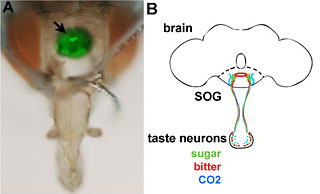UC Berkeley Press Release
Flies prefer fizzy drinks
BERKELEY – Fruit flies like a little seltzer in their drinks, according to researchers at the University of California, Berkeley.
While you may not catch a fly sipping Perrier, the insect has specialized taste cells for carbonated water that probably encourage it to binge on food with growing microorganisms. Yeast and bacteria both produce carbon dioxide (CO2) when they feast, and CO2 dissolves readily in water to produce seltzer or soda water.
 The exposed brain of a fly with a superimposed image of fluorescently labeled taste neurons in the region called the subesophageal ganglion. The diagram at right shows how the three identified taste cells on the fly's proboscis – sweet (green), bitter (red) and carbonated (blue) – send their axons through the proboscis to the brain. The bright green spot in the brain on the left correspond to the red halo in the right photo. (Kristin Scott/UC Berkeley, courtesy of Neuron) |
This is one of the first, if not the only taste sensation discovered in animals beyond the five that humans taste - sweet, sour, bitter, salty and umami, or savory.
"This was unexpected, because fruit flies also smell CO2 and they avoid it," said neurobiologist Kristin Scott, assistant professor of molecular and cell biology at UC Berkeley. "One way that we like to think of it is that flies seek the right amount of rottenness - if fruit is only half rotten, producing a little CO2, it's good; if too rotten, it gives off a lot of CO2 and is bad tasting. They seek a balance."
Scott and her UC Berkeley colleagues, graduate students Walter Fischler, technician Priscilla Kong and postdoctoral fellow Sunanda Marella - all in the Department of Molecular and Cell Biology and the Helen Wills Neuroscience Institute - report their discovery in the Aug. 30 issue of Nature.
Mammals have five known types of taste receptors, though there may be more to discover, Scott said. Flies may have five distinct receptors also, but not the same ones mammals have. While Scott has shown that fruit flies can detect sweet and bitter compounds, and now carbonation, she has discounted their ability to taste umami and said that their ability to taste sour compounds is questionable. She and her lab continue to investigate other unknown taste modalities in fruit flies, which could be any of a number of tastes, such as salt or alcohol.
The discovery came when Fischler, frustrated that he could not find a chemical that stimulated an unknown type of fruit fly taste cell he had isolated, tested the cells' reaction to a drop of Samuel Adams beer. Surprised by a positive response, he tried to narrow down the taste preference to one of the many chemicals in beer. Flat beer and dry yeast, for example, did not work. That's when he discovered the leftover bottle of Calistoga mineral water.
As he was searching for beer components to test, he said, "I opened the refrigerator and looked in, when a light bulb went on in my head. Calistoga would be a great way of testing CO2."
The rest is history. Dry ice - frozen CO2 - produced a strong response, while high levels of gaseous CO2 produced a weak response in the taste cells. Sodium bicarbonate in a basic solution that does not contain CO2 bubbles did not work; bicarbonate in a solution with CO2 bubbles did. The liquid in which yeast grow, though not the yeast themselves, also elicited a response from the taste cell. These and a few other genetic tests narrowed the taste trigger down to dissolved carbon dioxide.
The preference for carbonation is weak compared with that for sweetness, Scott noted, implying that seltzer enhances taste or makes other tastes more acceptable. This makes sense because CO2 has no nutritional value, but is a byproduct of organisms - yeast and bacteria - that do provide nutrients, she said.
The newly discovered taste sensors for carbonation reside on their own structures, called taste pegs, on the tongue of the fly. While a fruit fly's four other taste cells are perched on the tip of bristles that cover the entire body, the carbonated water taste cells are clustered around the margins of the sponge-like tip of the proboscis, at the base of taste bristles.
Scott investigates taste cells, which are a type of nerve cell, and is characterizing the cells and genes associated with different tastes. So far, she and her laboratory colleagues have identified the sweet and bitter cells and some of the gustatory receptor genes that detect sweet and bitter compounds in fruit flies.
Fischler now is trying to isolate the actual receptor in the CO2-sensing nerve cell that grabs the CO2 molecule and sends a signal to the fly brain that there is carbonation in the food. It will then be possible to see if others, including humans, also have carbonation receptors on taste cells.
"There may be many more taste modalities in humans" than the five known today, said Scott. Even if CO2 is a taste unique to fruit flies, it's discovery suggests that other animals may have taste receptors tuned to important chemicals in their environment, she said, either to avoid them, as is the case with bitter chemicals, or seek them out, as is the case with sugars and CO2.
"Thus, taste modalities may differ according to nutritional needs," she and her colleagues wrote. "Alternatively, CO2 may be an unappreciated taste modality in many organisms."
This work was supported by a grant from the National Institute on Deafness and Other Communication Disorders of the National Institutes of Health and the Burroughs Wellcome Fund.

